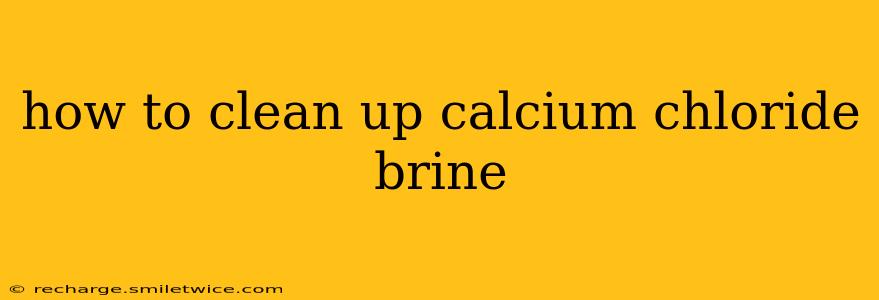Calcium chloride brine, while effective for de-icing and other applications, can leave behind unsightly and potentially damaging residues. Cleaning up spills and removing built-up brine requires a multi-pronged approach depending on the severity and location of the contamination. This guide will walk you through the process, answering common questions along the way.
What is Calcium Chloride Brine?
Before we delve into cleaning methods, let's briefly define calcium chloride brine. It's a solution of calcium chloride (CaCl₂) dissolved in water. Its effectiveness as a de-icer stems from its ability to lower the freezing point of water, preventing ice formation at temperatures well below 0°C (32°F). However, this very property, along with its hygroscopic nature (attracting moisture from the air), can lead to residue build-up.
How to Clean Up a Calcium Chloride Brine Spill?
The best approach for cleaning up a calcium chloride brine spill depends on the size and location of the spill.
Small Spills:
For minor spills on hard surfaces like concrete or pavement, simply flushing the area with plenty of water is usually sufficient. The water will dilute the brine and wash it away. Ensure the runoff is directed away from sensitive areas such as gardens or water sources.
Large Spills:
Larger spills require a more thorough cleanup. Consider these steps:
- Contain the spill: If possible, use absorbent materials like sand, kitty litter, or commercial spill absorbent pads to soak up as much of the brine as possible. This prevents further spreading.
- Neutralize (optional): While not always necessary for small-to-medium spills, some recommend neutralizing the brine with a mild base like baking soda. This reaction will produce harmless calcium carbonate (chalk), but it's crucial to use appropriate personal protective equipment (PPE) like gloves and eye protection. This step is less vital for larger spills, where the dilution from flushing is more effective.
- Flush thoroughly: After absorbing as much as possible, thoroughly flush the area with copious amounts of water to dilute and remove the remaining brine. A pressure washer can be helpful for larger areas.
- Disposal: Dispose of the collected absorbent material according to local regulations. This might involve contacting your waste management service.
How to Remove Calcium Chloride Brine Residue?
Persistent residues require more effort to remove. The best method depends on the surface:
Concrete and Pavement:
- Pressure washing: A pressure washer is often the most effective method. Use a strong spray nozzle to dislodge the residue. Follow up with a thorough rinsing.
- Chemical cleaners: In stubborn cases, commercial concrete cleaners might be necessary. Always follow the manufacturer's instructions carefully and ensure proper ventilation.
Other surfaces:
For other surfaces like metal or wood, specific cleaning agents may be needed. Always test a small, inconspicuous area first to ensure the cleaner doesn't damage the material.
How do I prevent calcium chloride brine buildup?
Preventing build-up is crucial. Consider these strategies:
- Appropriate application: Apply brine sparingly and only where needed, avoiding excessive amounts.
- Regular cleaning: Regularly sweep or wash away any brine residue before it has a chance to accumulate.
- Protective coatings: Consider applying protective coatings to susceptible surfaces to prevent brine penetration and staining.
What are the environmental concerns of calcium chloride brine?
Calcium chloride brine, while less toxic than some other de-icing agents, can still have some environmental impacts. Excessive use can contribute to soil salinity, potentially harming plant life. Runoff into waterways can also affect aquatic ecosystems. Therefore, responsible use and proper cleanup are essential to minimize negative environmental consequences.
Is calcium chloride brine harmful to pets?
Direct contact with concentrated calcium chloride brine can irritate pets' skin and paws. Ingestion can also cause gastrointestinal upset. Always keep pets away from areas where brine has been applied or spilled and clean up spills promptly.
Can I use household cleaners to clean up calcium chloride brine?
While water is usually sufficient for most spills, avoid using strong household cleaners, as some could react negatively with the brine or damage the surface being cleaned. For persistent residues, use commercial cleaners specifically designed for the type of surface.
By following these guidelines and addressing the common concerns, you can effectively clean up calcium chloride brine and minimize its potential negative impacts. Remember to always prioritize safety by using appropriate personal protective equipment and following instructions on any cleaning agents used.
